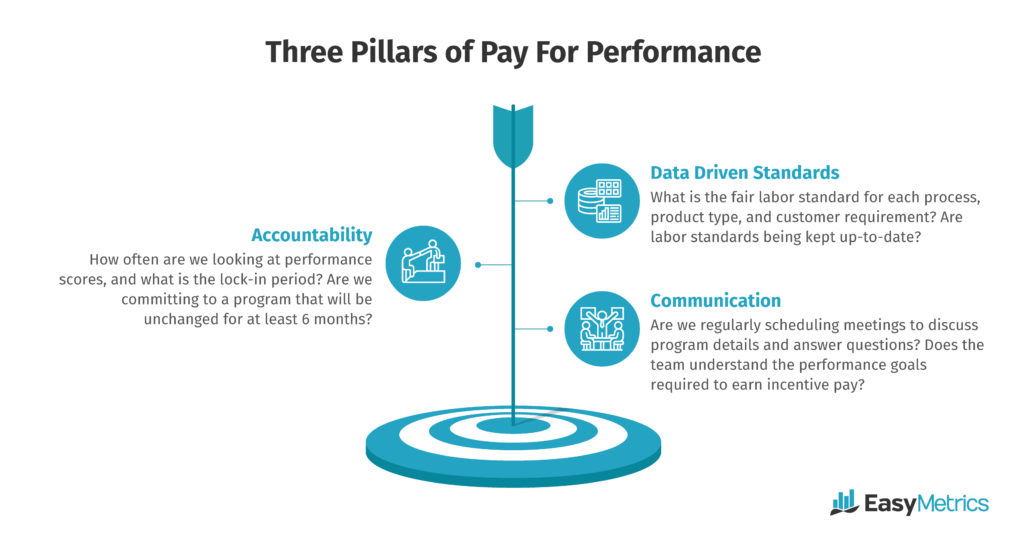Learn how to reveal costs by employee, and to transform that data into major productivity gains
Pay for Performance is the practice of offering employees financial rewards for optimizing their performance. Financially rewarding employees for achieving or beating a performance goal incentivizes efficiency and productivity. Employees view these personal performance bonuses as lucrative. 65% of workers in America prefer performance-based bonuses. Everyone is motivated by success; you’ll never see a sports game without a scoreboard.
The idea of performance-based pay isn’t a new one. These kinds of employee incentive programs have existed for as long as modern business. However, the simple concept of a pay for performance system (PFP) can encourage managers to launch a system without appropriate preparation and understanding. This leaves blind spots in implementation that lead to suboptimal returns on the company’s investment. In warehouse or production operations where labor varies by process and complexity, a poorly designed system can cripple both productivity and morale.
By contrast, a well-designed incentive plan can transform a struggling facility or warehouse team into one of your top performers. Manufacturing and warehouse employees, or operations teams in general, respond well to being rewarded directly for their performance. It incentivizes teams and individuals to initiate and maintain continuous improvement in their work and morale. This effect can cascade through an entire operations team, leading to a total morale and culture shift that benefits both the employees and the business.

Easy Metrics is a huge proponent of PFP systems; we have over two decades of experience designing and implementing them for our customers. We know how to navigate the intricacies of PFP, even in highly complex distribution environments, and can help you develop your own. Each program is unique, but the PFP plans we’ve seen succeed in production or warehouse environments follow strategies and design choices that will be discussed here.
Why Should I Implement Pay for Performance?
The idea of paying more money to save money might seem counterintuitive. However, this is one of the nuances of building a successful incentive program: how to manage rewards while staying in budget. It’s perfectly reasonable to wonder if a PFP system is appropriate–or even viable–for your business. The answer is almost always “yes”, but the follow-up question is “why?”
To answer that, let’s discuss the pros and cons of employee incentive programs:
Pros:
- Productivity gains can as much as double your operational efficiency, with the average improvement ranging between 10 and 20%.
- Reductions in indirect or lost or “missing” time directly lead to cost savings.
- Balanced reward systems encourage teamwork and positively transform the culture of the facility or the business as a whole.
- Employees can as much as triple their discretionary income, encouraging them to remain in your employment and continue doing their best work.
- You can identify which processes are inefficient due to employee motivation, and which are inefficient due to technical or design reasons.
- Employee morale will improve.
- Supervisors can transition from a taskmaster to a coach, focusing on helping their team succeed, and collaborate on solving problems with them, instead of pushing them.
- A robust system will be self-funding
Cons:
- A poorly-designed pay for performance model can backfire, losing you money and sabotaging your workplace morale.
- Employee incentive programs can be difficult to implement, without a dedicated team resource.
- The return on investment for employee rewards programs is not instant; these systems need time to build up momentum.
- You need to invest time and money into the analytics and reports to be able to build a successful system.
On the surface, it seems obvious that the pros of PFP systems outweigh the cons–and they do. But it’s not uncommon to hear about disastrous worker incentive programs that backfired horribly. This is why we stress the importance of working with experts who know how to carefully build a successful system on a proven framework. Do not attempt a PFP system without proper planning and fair, data-backed labor standards by process. An uninformed attempt can damage credibility, and hinder future pay-for-performance systems in your facilities.
What Makes A Good Pay For Performance System?
A stable and robust PFP system relies on three things: accountability, communication, and data-driven standards.

Communication:
Your employees should know what they’re being graded on, should be regularly, consistently informed of their successes, and should be treated with the assumption that they want to learn and improve their performance. Failure on any of these steps can make your employees feel left out, confused, disrespected, or ignored–none of which are conducive to progress.
The rewards structure should be clearly communicated as well. For example, are you rewarding your warehouse operators’ personal efforts linearly, where each point of improvement is worth its own bonus? Or are you using a tiered approach, where employees must strive to reach the next in a series of thresholds to get a flat bonus? Understanding and clearly communicating these incentive structures is key to getting your team involved.
Accountability:
Your employee rewards program should be designed in an easy-to-understand and consistent manner. If your system isn’t stable, or if you constantly change the performance standards or reward rates, your employees are going to become discouraged. Why bother working for a reward that might change or disappear tomorrow? To use an old analogy, dangling a carrot in front of your team is only good while the carrot is there. Randomly taking it away, or arbitrarily replacing it with something else, will make the workers give up on the system entirely. While other strategies and systems can be improved and used after a failure, PFP systems can’t. You have to get it right the first time.
Accountability goes the other way too. A good system will also encourage (or implicitly enforce) accountability and consistency from your workers as well. The best way to do this is to implement a “lock in” period. A lock-in period is the amount of time the employee is required to maintain their improved performance before their bonus is “locked-in”. This could also be viewed as your rewards schedule–do you look at performance scores on a daily basis? What about weekly? These things will help keep employees accountable, provided they’re implemented properly.
Data-Driven Standards:
Credible, defensible and fair performance standards are fundamental to a successful PFP program. Don’t pull performance standards out of thin air, and do not assume that all processes should operate on the same standards. The only way to investigate and set fair performance standards is to gather and examine the data for your various processes, departments, product types, and facilities. An analytics tool that creates machine learning performance standards, like Easy Metrics, can give you reliable and accurate performance standards across your entire operation, and from there you can calculate stretch goals for bonus eligibility.
It’s important to make sure that the data dictates the performance standards for each individual process, otherwise, you’ll accidentally create jobs that arbitrarily pay more than others within your workplace; teammates will lobby for shifts on the “good” jobs, and neglect the others. That causes friction between teammates and managers because it isn’t fair that some people get assigned the coveted shift or process, and other people are doing well on harder work and not getting proportionately compensated for it. Fair, objective and defensible performance standards are critical to minimize any friction between teammates, or favoritism from supervisors–whether real or perceived.
What Can Destroy A Pay For Performance System?
The fastest way to destroy a Pay for Performance system is poor management accountability. Are the performance standards uneven, arbitrary, or unrealistic? Then your operations teams are going to give up on any chance at rewards; and your PFP system is dead on arrival. Are you inconsistent with the rewards for each level of bonuses or inconsistent in paying out those bonuses? The same reaction occurs, with the costly side effect of completely eroding the goodwill, faith, and loyalty of your employees. You will lose your workers. The same thing will occur if you change your performance standards without notice and rationale.
Aside from accountability, worker incentive programs fail due to poor design. The most glaring failure (aside from unfair standards) that contributes to these failures is a long lock-in period. While it might seem reasonable on the surface to implement a monthly lock-in period–you want to make sure the performance gains stick around, after all–the reality is much more disappointing. Humans aren’t machines; they will have variable days. If an employee gets sick, or if something happens that’s outside of their control, then they will lose all of their bonus for that time period. This is incredibly demoralizing, and can actually drop efficiency and leave you worse off than you started.
The longest lock-in period that we can possibly recommend is weekly–and that’s only for specific industries that have rare non- variable workflow mix. Daily lock-ins are better. Most people think about what’s right in front of them; encouraging people to do their best work today will be more effective than encouraging them to work harder all week–even if the net output is theoretically the same.
What Indicates A Successful Pay for Performance Program?
A PFP program’s success is easily measured by two primary metrics: employee engagement and cost savings. Secondary metrics are: new-hire recruiting efficiency & cost, safety, retention, turn-over, and attendance.

A well-designed program directly and proportionately rewards employees for their individual work that they have control over. Don’t tie PFP rewards to results that are out of the individual employee’s control. For example, if bonuses are tied to the profits of the company, there isn’t a direct relationship between the employee and the bonus. A better method is to set goals on direct and indirect processes that the individual can work on, improve, and be engaged with. This sense of accountability and ownership translates to employee engagement. This direct influence also encourages employees to innovate and reduce costs, because that too can affect their bonuses.
The other hallmark of a successful program is the cost. A successful program should not cost money; the idea is to share the cost savings between your company and your teammates. Easy Metrics’ incentive pay solutions are 100% self-funded through productivity increases. Our Pay for Performance systems save you money and benefit your workers–everyone wins.
How Can We Help?
Easy Metrics has a purpose-built solution for Pay for Performance. We’ve developed hundreds of pay-for-performance systems for 3PLs, retail brands, e-commerce, wholesale distribution, food processing and cold chain, and manufacturing. We can help you create a Pay for Performance program that is built for success from the start, giving you unprecedented visibility into your operation’s labor cost and performance. Chances are, you already have all the data you need to get started.
Talk with a member of our team about pay for performance: https://www.easymetrics.com/contact/





